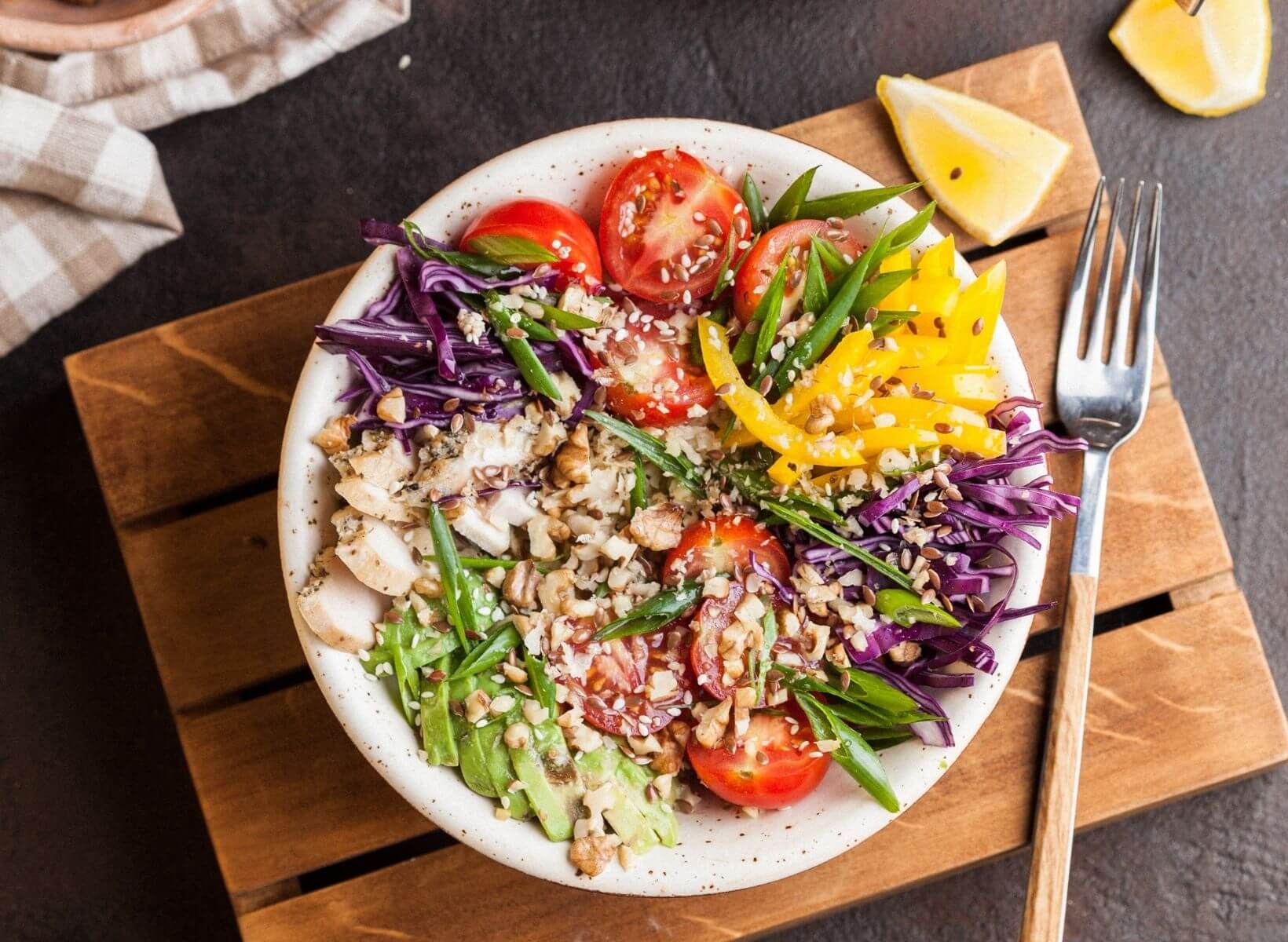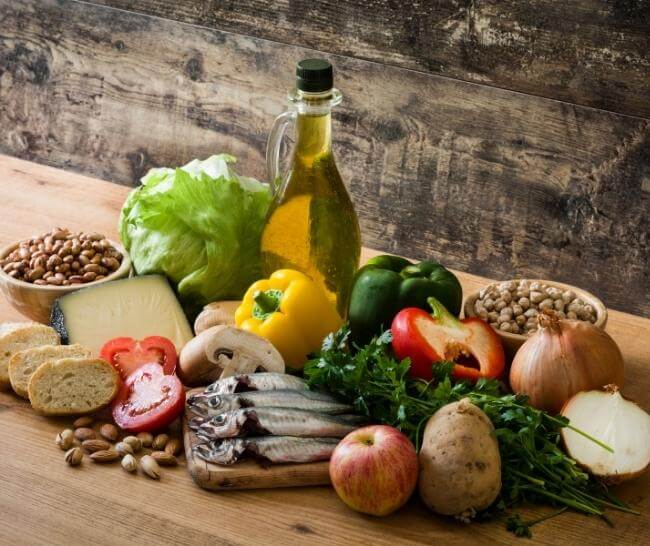Gout is an inflammatory and painful arthritis that occurs when high levels of uric acid in the blood accumulate. Excessive uric acid causes monosodium urate crystals to form in joints, usually starting in the big toe, knee, and fingers, but can affect any joint in the body. The joint becomes swollen, stiff, red, hot, and tender.1, 2
Your body makes uric acid as it metabolizes (or breaks down) purines. Some foods contain purines, which account for one-third of the purines in the body. The other two-thirds of purines are naturally occurring.1
Following a gout diet and avoiding specific foods with purines along with medication can decrease the frequency of gout flare-ups. A gout diet can help manage most other health conditions simultaneously.
Let’s learn more about the gout diet and purines and explore the benefits and drawbacks of a low-purine meal plan with foods to choose from and avoid.
{{mid-cta}}
Purines and Gout: What Is the Link?
For most people, the body can remove any excess uric acid on its own. People with gout have a buildup of uric acid, leading to painful crystal formation in the joints.1, 2
Reducing dietary purines lessens the amount of purines and uric acid in the body, helping to manage gout.1, 2
Unmanaged gout progresses the condition and the frequency of attacks, leading to permanent damage to joints and the kidneys that help break down uric acid.1, 2, 4
Some people are more at risk for developing gout. The typical Western or American Diet is high in sugar, saturated fats, and meats and low in fiber, further exacerbating uric acid levels.
Who Should Follow a Gout Diet?
Certain people are more at risk for developing gout than others. Gout affects more men than women. It is also more common in people who carry extra weight and those with certain health conditions like diabetes, metabolic syndrome, or kidney disease.1, 2
Other risk factors for gout include:
- Genetics of family history of gout increases your risk
- Toxin or lead exposure
- Illness or major surgery can lead to a gout attack
- Certain medications can increase your risk (diuretics, aspirin, and niacin)
- Dietary choices like high intakes of meat, sugar or fructose, seafood, and alcohol1, 2
A gout diet does not cure gout, but it does help manage gout and other health conditions. If you have high levels of uric acid, following a low-purine (gout) diet may help reduce the circulating levels of uric acid, reducing the risk of crystal formation in the joints.1, 2
What Diet Is Recommended for Gout?
Any diet that is lower in purines is recommended for gout. Additionally, including key diet components like adequate fiber, vitamins, and minerals can help reduce your risk of gout by improving your overall health and inflammation.1
The Mediterranean Diet or the Dietary Approaches to Stop Hypertension (DASH) diet optimizes fiber, vitamin and mineral intake, and anti-inflammatory foods while reducing high-sugar foods and overconsumption of meats that can exacerbate gout.1
Vitamin C, vitamin E, and vitamin A in fruits and vegetables reduce inflammation, stress, and uric acid levels. Sufficient mineral intake, including potassium, zinc, calcium, iron, and selenium, is important for optimal kidney function and fluid status.1
All meat and plant foods contain purines, some in higher amounts. Maintaining a balanced intake of lower purine foods can help reduce excessive levels of uric acids.
For a balanced diet, consume a mix of vegetables, fruits, whole grains, complex carbs, nuts, seeds, lean animal and dairy foods, and plant protein.
While vegetables, grains, and dairy products have purines, research shows these foods do not cause gout attacks. Low-fat dairy is thought to lower uric acid levels.1, 2
The following foods are recommended to help manage or prevent gout.
- Nuts or nut butter (like peanut or almond butter)
- Whole grains and pasta (oats, whole wheat, quinoa, brown rice, lentils, or barley)
- All fruits
- All vegetables
- Low-fat dairy products (skim milk, yogurt, kefir, and cheese)
- Eggs
- Chicken and some fish (salmon)
- Soybean and soy products (tofu, edamame, soymilk)
- Unsaturated fats and oil (found in olive or avocado oil, seeds, nuts, and nut butters, and fatty fish like salmon)
- Coffee
- Water
Gout Diet: What to Avoid or Limit

High-purine foods include seafood and any organ or glandular meat (liver, kidneys, tripe, bone marrow, brain, heart, stomach, or lungs).
All types of alcohol (which has no purines) trigger purine breakdown, leading to the rapid increase of uric acid levels.
Yeast-rich foods like bread can gradually increase uric acid levels, but this is less impactful than high-purine foods, alcohol, and overconsumption of animal meat or saturated fat.1, 2, 3
The following foods are associated with increased risk of gout or uric acid levels.
- Saturated fat intake and overall high-fat diet
- Alcohol (all types)
- Overconsumption of any animal proteins
- Seafood (anchovies, sardines, herring, mussels, codfish, scallops, trout, and haddock)
- Organ meats (liver, kidneys, tripe, bone marrow, brain, heart, stomach, or lungs)
- Bacon, turkey, veal, and venison
- Lamb, pork, and red meat
- Sugary and high fructose foods (soda or sweetened beverages, baked goods, desserts, candy, foods with high fructose corn syrup)
<div class="pro-tip"><strong>Also Read: </strong><a href=gerd-diet>GERD Diet: Foods for Acid Reflux and What to Avoid</a>.</div>
Benefits and Downsides of Gout Diets
While reducing your purine intake can help reduce uric acid levels, it only makes up one-third of the purine in your body. The other two-thirds is naturally occurring for the rest of your body systems to work properly.1
There are benefits and downsides to using a gout diet to prevent flare-ups.
On one side, it’s unrealistic to expect diet alone to always lower uric acid levels, especially in individuals with high levels.
It can become an unnecessary burden to completely avoid all foods and drinks that raise uric acid levels. Medication may be needed to prevent gout attacks and help you have a little margin to enjoy alcohol, sweets, and purine-rich foods occasionally.
Other people may find that changing their diet is enough to prevent gout attacks and empower them to manage their health conditions effectively.
Work with your health care providers and a registered dietitian to determine the extent you should restrict purines and if dietary changes can lower uric acid levels to the point you prevent gout.
Benefits
- Weight loss
A gout diet emphasizes fruits, vegetables, whole grains, lean protein in moderation, low-fat or nonfat dairy, nuts, seeds, and some fatty fish like salmon.
Filling up on these nutrient—and fiber-rich foods will help you eat fewer sugary, processed, and high-fat foods, leading to weight loss.
High uric acid levels are seen in 60% of people who are overweight or obese.1
The Mediterranean Diet (while also appropriate for gout) can help overweight adults lose weight and improve heart disease risk factors and glycemic control.5
- Uric acid reduction
Both the Mediterranean Diet and the DASH Diet are similar and can reduce uric acid levels and the incidence of gout.1, 6
Higher adherence to the DASH diet reduced the incidence of gout by 40% in a large study including over 44,000 men.6
- Medication reduction
You may need less medication to lower uric acid levels as you consume foods and drinks that are lower in purines. Work with your healthcare providers to determine when you can lower your medications.
Downsides
- It does not cure gout
What you eat impacts about one-third of the purines and uric acid in your body, leading to crystal formation. Diet can reduce your levels but not cure gout.
Most treatment plans recommend a multi-faceted approach: a low-purine diet, medication to lower uric acid, and lifestyle habits to maintain a healthy weight.1
- It is a restrictive diet
A gout or low-purine diet restricts many foods, including seafood, certain meats, alcohol, high-sugar foods, and drinks. Eliminating these foods indefinitely can be discouraging and unrealistic for some.
Work with a registered dietitian to develop an individualized eating plan that reduces high-purine foods but still allows you some flexibility and variety. Pairing a reduced-purine diet with medication can help you achieve target uric acid levels.
- Limited omega-3 sources
With gout, you have to be intentional about your beneficial omega-3 fat sources. Many omega-3 fat options are high in purines, like anchovies and sardines.
Consider salmon, walnuts, flax seeds, supplements, and tuna for low or moderate-purine foods that contain omega-3 fats. Omega 3 fats are important for heart health and reducing inflammation.7
Learn More About How to Improve Blood Sugar Health With Signos’ Expert Advice
A gout or low-purine diet is one way to lower your uric acid levels and prevent gout. A Mediterranean or DASH diet can help you lower your purine levels and reap other health benefits like improved blood glucose control and reduced heart disease risk.
A Signos continuous glucose monitor (CGM) can help you monitor blood sugar levels, improve your health, and encourage you to adopt healthier eating habits as you aim to prevent or manage health conditions like type 2 diabetes or gout.
Learn more about nutrition and healthy habits on Signos’ blog written by health and nutrition experts. Take a quick quiz to determine if Signos fits your needs.
<div class="pro-tip"><strong>Learn More: </strong><a href=what-to-eat-before-bed-to-lose-weight>What to Eat Before Bed to Lose Weight: Best 12 Foods</a>.</div>
- Item 1
- Item 2
- item 3
Topics discussed in this article:
References
- https://pubmed.ncbi.nlm.nih.gov/36079783/
- ttps://www.eatright.org/health/health-conditions/arthritis-and-inflammation/gout
- https://pubmed.ncbi.nlm.nih.gov/30485934/
- https://www.arthritis.org/health-wellness/healthy-living/nutrition/healthy-eating/which-foods-are-safe-for-gout
- https://pubmed.ncbi.nlm.nih.gov/30389673/
- https://pubmed.ncbi.nlm.nih.gov/28487277/
- https://ods.od.nih.gov/factsheets/Omega3FattyAcids-Consumer/
































